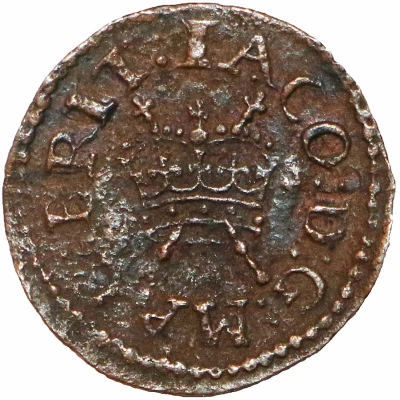


© John Conduitt (CC BY-SA)
1 Farthing - James I Lennox issue; type 2 ND
| Copper | 0.72 g | 15 mm |
| Issuer | England (United Kingdom, British Overseas Territories and Crown Dependencies) |
|---|---|
| King | James I (1603-1625) |
| Type | Token |
| Years | 1614-1624 |
| Value | 1 Farthing (1⁄960) |
| Currency | Pound sterling (1158-1970) |
| Composition | Copper |
| Weight | 0.72 g |
| Diameter | 15 mm |
| Shape | Round (irregular) |
| Technique | Roller milled |
| Orientation | Coin alignment ↑↓ |
| Demonetized | Yes |
| Updated | 2024-10-09 |
| Numista | N#156625 |
|---|---|
| Rarity index | 83% |
Reverse
Central crowned harp with legend around, mintmark at 11 o'clock.
Script: Latin
Lettering: FRA:ET HIB:REX·
Unabridged legend: Franciae Et Hiberniae Rex
Translation: France and Ireland (continuation of obverse legend)
Comment
House of Stuart (1603-49), James I (1603-25), Copper farthing token, production contracted to Lord Lennox.Everson type 2; mintmark Flower or Fusil on both sides.
Interesting fact
One interesting fact about the Token 1 Farthing - James I (Lennox issue; type 2) ND (1614-1624) from England (United Kingdom, British Overseas Territories and Crown Dependencies) made of Copper weighing 0.72 g is that it was issued during a time of great economic turmoil in England. The early 17th century saw a severe shortage of small change, which led to the issuance of private tokens, like this one, by merchants and traders to fill the gap. This coin, in particular, was issued by the Earl of Lennox, who was a prominent Scottish nobleman and a member of the royal family. Despite its small denomination, the coin was made of copper, which was a valuable resource at the time, and its design featured an image of the king, James I, on one side and a shield with the Lennox family crest on the other. This coin is a rare and interesting example of the diverse and innovative ways that people have used currency throughout history to facilitate trade and commerce.



